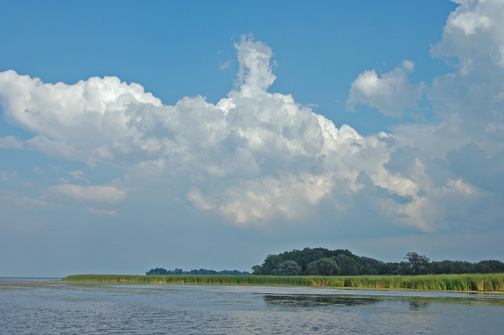 |
Earthen embankments meant to stem tidal flooding
are preventing the deposition of sediment
which is necessary to maintain elevation |
A team of scientists from Vanderbilt University has found that what looked like 'sea-level rise' may be something else entirely in a low-lying region of Bangladesh. The deposition of sediment is constantly needed to replenish land and prevent flooding.
"Man-made flood protections, not climate change, are the main culprit in sea-level rise in southwest Bangladesh, according to new research conducted for the U.S. Navy's Office of Naval Research. The report is the first part in a wide-ranging, $7.5 million analysis of environmental stress and human migration scenarios in the low-lying South Asian nation." -- reported in Jan. 7, 2015 Scientific American.
According to a Jan. 8, 2015 article in The Hindu, "Bangladesh’s estuarine islands are sinking, and ironically, this could owe to embankments built to protect them from tidal erosion. Some islands have sunk by as much as 1.5 metres in the last 50 years, says a study published recently in the journal Nature Climate Change."
"The over 50 large islands in southwest Bangladesh, once forested but now primarily rice growing, were embanked in the 1960s and 1970s to protect them against tidal and storm-surge inundation. But these earthen embankments, while buffering them against floods, have also prevented the deposition of sediment that helps maintain an elevation in this area."
"The loss of elevation was felt most significantly during the 2009 cyclone Alia when large areas of land were left inundated for up to two years. “Despite sustained human suffering during this time, the newly reconnected landscape received tens of centimetres of tidally deposited sediment, equivalent to decades’ worth of normal sedimentation,” says the paper. Deforestation and a regionally increased tidal range have contributed to the phenomenon, say the researchers from Vanderbilt University, Tennessee, U.S. and Khulna University, Bangladesh. Interestingly, while these islands in the Ganges–Brahmaputra river delta are fast submerging, putting millions of inhabitants at risk of flooding, the neighbouring Sundarbans mangroves are stable from their natural shield of vegetation, the paper adds."
"Researchers used GPS and a theodolite survey of land elevations at an island called Polder-32 in southwest Bangladesh and compared it with the Sundarbans. They found that the mean elevation of Polder-32 is 1.15 metres lower than Sundarbans."
"The study therefore implicates 'direct human modification of the environment' and not global sea-level rise as the most important agent of change in the western Ganges Brahmaputra tidal delta plain, says the paper."
“The striking contrast between the tidal inundation patterns of these landscapes highlights the impact of sediment starvation and the historical loss of elevation, which has severely exacerbated the effects of tidal inundation,” notes the paper."
"However it is possible to recover some of the lost ground, say the authors adding that 'controlled breaching of embankments' can restore elevation and relieve environmental problems. 'The silver lining for Bangladesh and the delta system remains the one billion tons of river sediment that may be effectively dispersed onto the landscape to alleviate elevation deficits. On the basis of our observations, a feasible management strategy from the physical-science perspective may be to systematically breach embankment sections to facilitate sediment delivery and elevation recovery.'”


